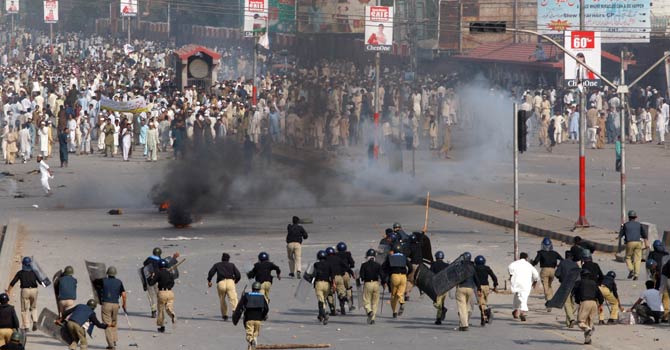Friday which was designated by the government to demonstrate love of the Holy Prophet (peace be upon him) and condemn the anti-Islam video produced in the US by some extremists was hijacked by our home-grown extremists who turned it into a day of unbridled violence, killings, arson and robbery.
At least 23 people were killed and over 200 injured and violence in some places continued till late in the night.
The internal security system virtually collapsed, giving way to tens of thousands of violent protesters to rule the streets in several cities, from Peshawar and Islamabad to Lahore and Karachi, burn down shops, cinema houses and police vehicles, and ransack whatever else that came in the way.
For most part of the day it was complete anarchy in several cities, including the federal capital, leaving a trail of death and destruction in large parts of the country.
Highly charged, and in places armed and well-equipped, the protesters tore down barricades, removed or overturned huge containers that had been put up by the authorities to block main thoroughfares, and to protect government buildings and diplomatic compounds, and set ablaze government and private property.
Within a matter of a few hours it became quite evident that the ill-equipped and poorly trained, and perhaps ill-motivated, police force was not in a position to push back the violent protesters.
The extensive use of tear gas and rubber bullets proved futile as in many cases the riot police had to take the beating with protesters throwing back the tear gas canisters and stones at them.
As violence intensified in places like Peshawar and Karachi, riot police first fired live ammunition in the air, and then at places directly into the crowd. In Peshawar and Karachi, and some other places, several bystanders and journalists got trapped as protesters and police clashed, using bricks, stones, tear gas and even live ammunition. There were deaths and injuries on both sides, with a number of people, including member of a television crew, becoming victim of this madness.
FALSE COMFORT: The anarchic scenes witnessed during the later part of the day were much in contrast to the way the country looked early in the morning. As the day dawned, the streets in almost all the cities were virtually deserted, giving the false impression that the call by the government for a public holiday and peaceful protest may encourage the general public, as well as the protesters, to remain confined to their homes.
The authorities had taken extraordinary measures in Islamabad, Peshawar, Lahore and Karachi by bringing in scores of containers, tankers and trucks to block avenues and by-lanes leading to the American and other diplomatic missions, and offices of senior government functionaries.
By switching off mobile network in 15 major cities and with the deployment of huge police and paramilitary force, the authorities seemed convinced that the day would pass off peacefully.
But the planners and perpetrators of violence had other plans.
The trouble started early in the day from Peshawar. As Prime Minister Raja Pervez Ashraf was addressing an officially called convention in Islamabad, condemning the anti-Islam movie and making a passionate appeal for calm, hundreds of supporters of religious parties had started to attack and set ablaze shops and cinema houses in the capital of Khyber-Pakhtunkhwa.
But the real wave of violence in the country started soon after Friday prayers. Initially it appeared that the rallies that were being taken out by religious groups ranging from Jamiat Ulema-i-Islam, Jamaat-i-Islami, Sunni Tehrik and Majlis-i-Wahdatul Muslimeen, as well as some mainstream political parties, might remain peaceful.
However, within no time many militant members of various groups, with sticks and other blunt instruments in their hands, started to make their way towards the police barricades.
Reports gathered from all over the country suggest that the pattern was almost the same: first try to penetrate through the barricades on foot or motorcycles, and on finding little resistance, bring down the containers to allow the processions to enter what were officially described as high security ‘red zone’.
At other places protesters found public and private property like police kiosks, cinema houses, shops and cars as easy target. Gradually violence started to spread to large parts of these cities, with police looking completely helpless and other law-enforcement agencies appearing like silent spectators.
As a number of leaders of religious groups defended the public anger and blamed the government for not doing enough to condemn the West, government leaders like Information Minister Qamar Zaman Kaira strongly condemned the perpetrators of violence. He even criticised the electronic media for its live coverage of violence which, according to him, helped in instigating trouble in most parts of the country.












































